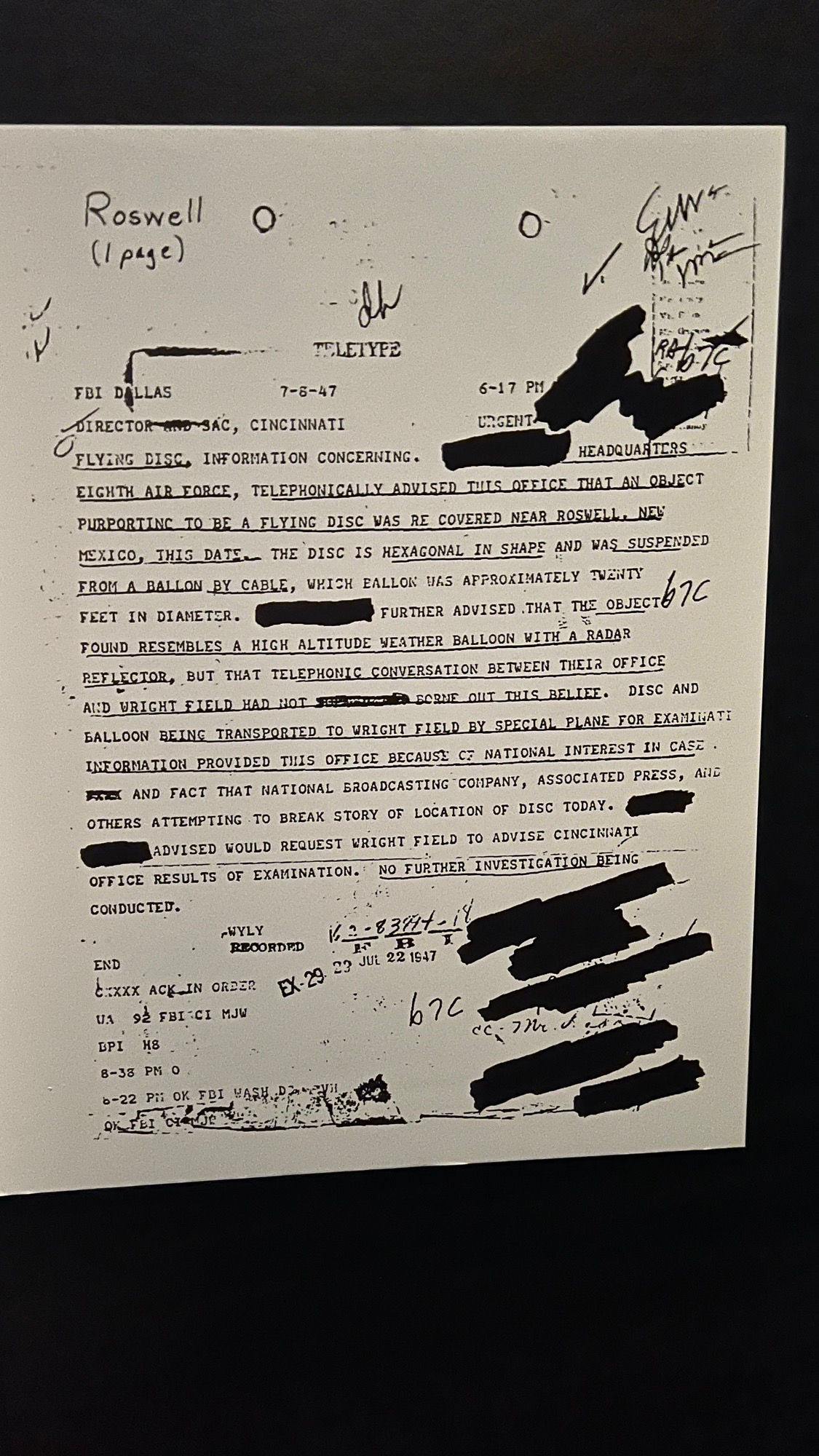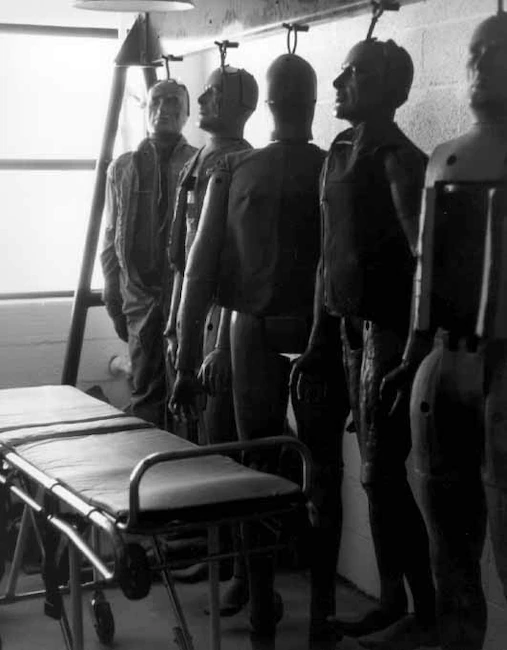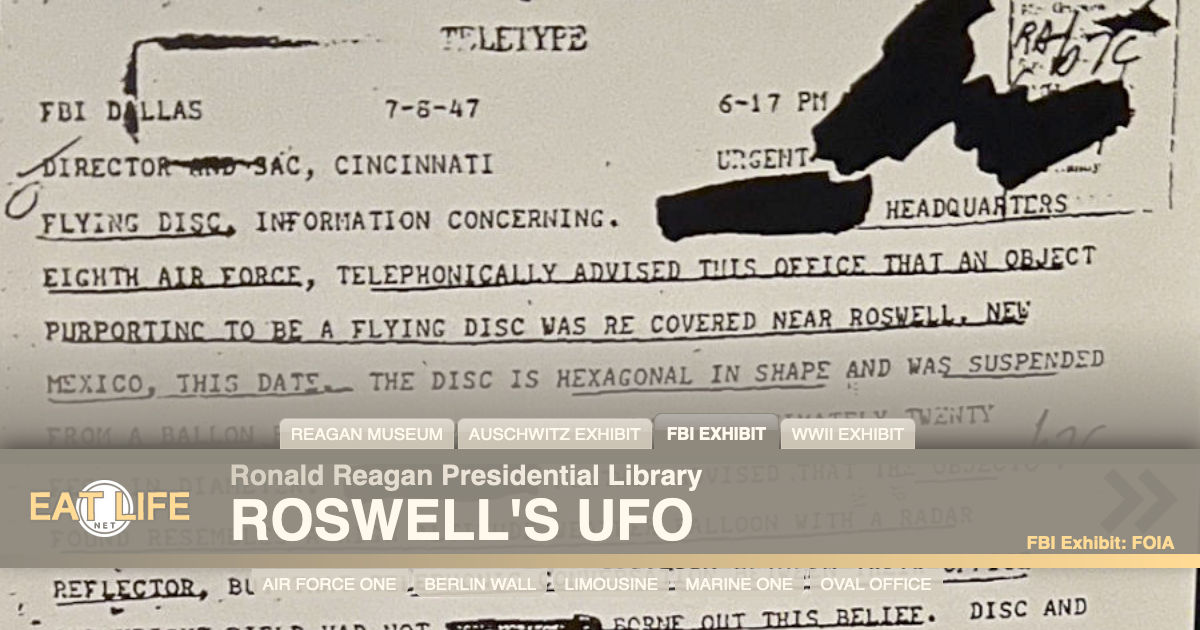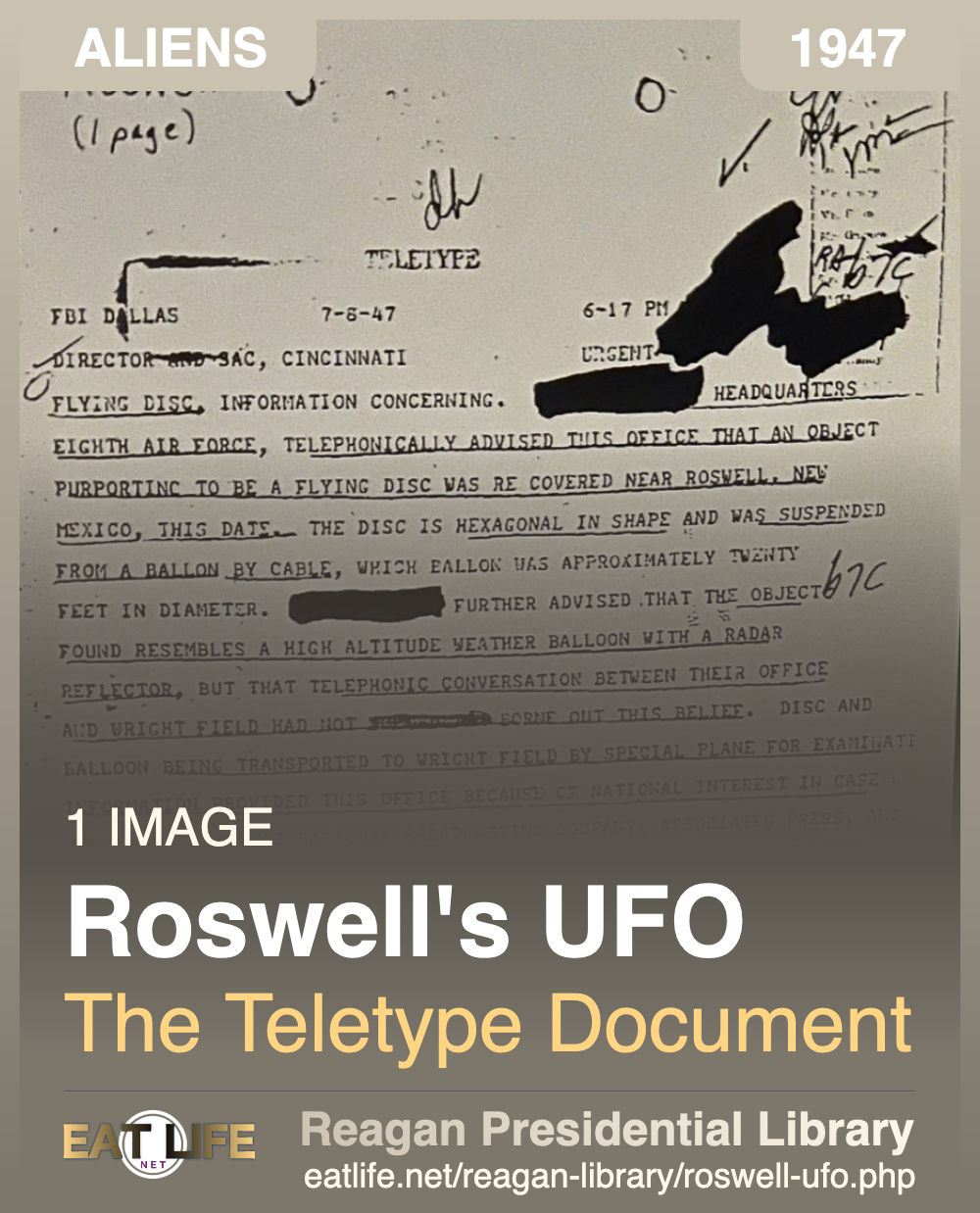
Director and SAC, Cincinnati Urgent
7-8-47
Flying Disk, Information Concerning Headquarters Eighth Air Force, telephonically advised this office that an object purporting to be a flying disc was recovered near Roswell, New Mexico, this date. The disc is hexagonal in shape and was suspended from a balloon by cable, which balloon was approximately twenty feet in diameter. XXXXXXXXXX further advised that the object found resembles a high altitude weather balloon with a radar reflector, but that telephonic conversation between their office and Wright Field had not XXXXXXXXXX borne out of this belief. Disc and balloon being transported to Wright Field by special plane for examination. Information provided this office because of national interest in case. XXXXXXXXXX and fact that National Broadcasting Company, Associated Press, and others attempting to break story of location of disc today. XXXXXXXXXX XXXXXXXXXX advised would request Wright Field to advise Cincinnati Office results of examination. No further investigation being conducted.
FBI Roswell UFO
On July 8, 1947, the FBI Dallas Field Office sent a teletype regarding a "flying disc" that resembled a high altitude weather balloon found near Roswell, New Mexico.
FBI UFO
In 1947, a rash of sightings of unexplained flying objects (UFOs) swept America. Although the newly formed U.S. Air Force was the primary investigator of these sightings, the FBI received many reports and worked for a time with the Air Force to investigate these matters. This release details the FBI's role in investigating such reports between 1947 and 1954.
History.com Roswell Incident
In the annals of American UFO history, few incidents have inspired as much fascination-and speculation-as the one in Roswell, New Mexico.It began in the summer of 1947, at the dawn of the Cold War, when the U.S. Army Air Forces sent out a shocker of a press release, announcing they'd recovered a "flying disc" from a ranch near Roswell. More than 70 years later, the incident remains a defining aspect of the area's identity: The town boasts a UFO museum and research center, a flying saucer-inspired McDonald's, alien-themed streetlights, even an extraterrestrial "family" stranded in a broken-down UFO on the side of State Route 285, looking for a jump-start.
But behind all the UFO mania lies an uneasy truth. The events that transpired that summer are anything but clear-cut, with admitted coverups and conflicting explanations: It was a saucer! It was a spy craft! It was the Soviets!
And new ones are still emerging.
Here are the agreed-upon facts about the Roswell crash
Sometime between mid-June and early July 1947, rancher W.W. "Mac" Brazel found the wreckage on his sizable property in Lincoln County, New Mexico, approximately 75 miles north of Roswell. Several "flying disc" and "flying saucer" stories had already appeared in the national press that summer, leading Brazel to believe the wreckage-which included rubber strips, tinfoil, and thick paper-might be something of that ilk. He brought some of the material to Sheriff George Wilcox of Roswell, who in turn brought it to the attention of Colonel William Blanchard, the commanding officer of the Roswell Army Air Field (RAAF).The next day, the RAAF released a statement, writing that, "The many rumors regarding the flying disc became a reality yesterday when the intelligence office of the 509th Bomb Group of the Eighth Air Force, Roswell Army Air Field, was fortunate enough to gain possession of a disc through the cooperation of one of the local ranchers and the sheriff's office of Chaves County."
According to that statement, Major Jesse Marcel, an intelligence officer, oversaw the RAAF's investigation of the crash site and the recovered materials.
The government changed its story about the Roswell 'saucer' - a few times
The following day, the Roswell Daily Record ran a story about the crash and the RAAF's astonishing claim. But U.S. Army officials quickly reversed themselves on the "flying saucer" claim, stating that the found debris was actually from a weather balloon, releasing photographs of Major Marcel posing with pieces of the supposed weather balloon debris as proof.For decades, many UFO researchers were skeptical of the government's changed account, and in 1994, the U.S. Air Force released a report in which they conceded that the "weather balloon" story had been bogus. According to the 1994 explanation, the wreckage came from a spy device created for an until-then classified project called Project Mogul. The device-a connected string of high-altitude balloons equipped with microphones-was designed to float furtively over the USSR, detecting sound waves at a stealth distance. These balloons would ostensibly monitor the Soviet government's attempts at testing their own atomic bomb. Because Project Mogul was a covert operation, the new report claimed, a false explanation of the crash was necessary to prevent giving away details of their spy work.
Other elements of the Roswell story-namely that some eyewitnesses claimed that there were alien bodies taken from the site-were explained as fallen parachute-test dummies in a more extensive follow-up report in 1997.
Roger Launius, a historian and retired curator for the Division of Space History at the Smithsonian National Air and Space Museum, says those two reports close most of the remaining questions about Roswell.
"This story has been resolved," Launius says. "Has absolutely every question been answered? I can't say that. But I'm not sure that there are significant holes."
"You do not divulge state secrets in the context of national security… My surmise is they probably saw [the initial flying saucer explanation] as a useful cover story."
Donald Schmitt, a UFO researcher who has spent nearly three decades investigating the Roswell incident and is the co-founder of the International UFO Museum and Research Center in Roswell, says that explanation makes little sense. The "flying saucer" story, he contends, was so ostentatious that it was bound to draw attention to the area, with its sensitive military operations at the time. Doing so would seem highly counter to the interests of the War Department.
SchmittTwo hours west of Roswell the first atomic bomb was detonated. You had ongoing atomic research at Los Alamos. You had all this testing of captured German V-2 rockets at White Sands. And at Roswell, you had the first atomic bomb squadron headquartered, The thought that they would have intentionally set up any type of publicity as a distraction? If anything, they needed less attention.
Air Force Exhaustive Records Search
In July 1994, the Office of the Secretary of the Air Force concluded an exhaustive search for records in response to a General Accounting Office (GAO) inquiry of an event popularly known as the "Roswell Incident." The focus of the GAO probe, initiated at the request of a member of Congress, was to determine if the U.S. Air Force, or any other U.S. government agency, possessed information on the alleged crash and recovery of an extraterrestrial vehicle and its alien occupants near Roswell, N.M. in July 1947.The 1994 Air Force report concluded that the predecessor to the U.S. Air Force, the U.S. Army Air Forces, recovered debris from an Army Air Forces balloon-borne research project code named MOGUL. Records located describing research carried out under the MOGUL project, most of which were never classified (and publicly available) were collected, provided to GAO, and published in one volume for ease of access for the general public.
This report discusses the results of this exhaustive research and identifies the likely sources of the claims of "alien bodies" at Roswell. Contrary to allegations, many of the accounts appear to be descriptions of unclassified and widely publicized Air Force scientific achievements. Other descriptions of "bodies" appear to be actual incidents in which Air Force members were killed or injured in the line of duty.
The Conclusions Are
Air Force activities which occurred over a period of many years have been consolidated and are now represented to have occurred in two or three days in July 1947."Aliens" observed in the New Mexico desert were actually anthropomorphic test dummies that were carried aloft by U.S. Air Force high altitude balloons for scientific research.
 Anthropomorphic Dummies
Anthropomorphic Dummies
Alderson Laboratories anthropomorphic dummies of the type dropped from balloons.The "unusual" military activities in the New Mexico desert were high altitude research balloon launch and recovery operations. Reports of military units that always seemed to arrive shortly after the crash of a flying saucer to retrieve the saucer and "crew," were actually accurate descriptions of Air Force personnel engaged in anthropomorphic dummy recovery operations.
Claims of "alien bodies" at the Roswell Army Air Field hospital were most likely a combination of two separate incidents:
1A 1956 KC-97 aircraft accident in which 11 Air Force members lost their lives
2A 1959 manned balloon mishap in which two Air Force pilots were injuredThis report is based on thoroughly documented research supported by official records, technical reports, film footage, photographs, and interviews with individuals who were involved in these events.
WIKIPEDIA The Roswell Incident
was the July 1947 recovery of metallic and rubber debris from a military balloon by Roswell Army Air Field personnel, who issued a press release announcing possession of a "flying disc". Decades later, conspiracy theories claimed that debris from an alien spaceship had been covered up by the government. In response, in 1994 the United States Air Force published a report concluding the crashed object was a top secret nuclear test surveillance balloon from Project Mogul.The Roswell incident took place during the flying disc craze of 1947, sparked by widespread media coverage of pilot Kenneth Arnold's alleged sighting. Amid hundreds of reports nationwide, on July 8, 1947, Roswell Army Air Field's press release was broadcast via wire transmission. The Army quickly retracted the release, falsely stating the crashed object was merely a conventional weather balloon.
The incident was forgotten until 1978, when retired lieutenant colonel Jesse Marcel was interviewed by ufologist Stanton Friedman. In that interview, Marcel revealed the "weather balloon" had been a cover story to divert public attention. Based on this, Marcel speculated that the debris might have been extraterrestrial in origin.
Jesse Marcel's interview led to complex conspiracy theories about alien spacecraft recovery and military cover-ups by ufologists. In 1979, over three decades after Roswell, conspiracy theorists began to claim that extraterrestrial occupants had been recovered by the military at Roswell. In response to claims of alien occupants, a second USAF report in 1997 reviewed testimonies about aliens and found them to be baseless, made up, or inspired by parachute dummies.
Conspiracy theories about the event persist despite explanations linking the incident to Project Mogul, a military balloon or having been described as "the world's most famous, most exhaustively investigated, and most thoroughly debunked UFO claim". Its myth has become a cultural phenomenon and the Roswell incident continues to be of interest in popular media. Portrayals of the incident are a prominent and enduring trope in popular culture and mass media commonly associated with "grey aliens" and "flying saucers". The city of Roswell, New Mexico has embraced this cultural iconography; featuring a little green man on its seal and hosting numerous ufology attractions and events.











